Age-Dependent Changes in Nrf2/Keap1 and Target Antioxidant Protein Expression Correlate to Lipoxidative Adducts, and Are Modulated by Dietary N-3 LCPUFA in the Hippocampus of Mice
Abstract
:1. Introduction
2. Materials and Methods
2.1. Animals and Experimental Groups
2.2. Sample Preparation and Tissue Extracts
2.3. Western Blots
2.4. Statistics
3. Results and Discussion
3.1. Effects of Aging and Dietary n-3 LCPUFA Supplementation in Hippocampal Nrf2 Expression
3.2. Effects of Aging and Dietary n-3 LCPUFA Supplementation on Hippocampal Keap1 Expression
3.3. Effects of Aging and Dietary n-3 LCPUFA Supplementation on Nrf2-Keap1 Association
3.4. Effects of Aging and Dietary n-3 LCPUFA Supplementation on Hippocampal Markers of Lipoxidation
3.5. Effects of Aging and Dietary n-3 LCPUFA Supplementation on Hippocampal Markers of Nitrosylation
3.6. Effects of Aging and Dietary n-3 LCPUFA Supplementation on Hippocampal Expression of HO-1 and GPx4
3.7. Multivariate Associations between Nrf2, Keap1, HO-1, GPx4, and Lipoxidative/Nitrosative Variables in Response to Age–Diet Interactions
4. Conclusions
Supplementary Materials
Author Contributions
Funding
Institutional Review Board Statement
Informed Consent Statement
Data Availability Statement
Conflicts of Interest
References
- Díaz, M.; Fabelo, N.; Casañas-Sánchez, V.; Marin, R.; Gómez, T.; Quinto-Alemany, D.; Pérez, J.A. Hippocampal Lipid Homeostasis in APP/PS1 Mice Is Modulated by a Complex Interplay between Dietary DHA and Estrogens: Relevance for Alzheimer’s Disease. J. Alzheimers Dis. 2016, 49, 459–481. [Google Scholar] [CrossRef]
- Rosenzweig, E.S.; Barnes, C.A. Impact of Aging on Hippocampal Function: Plasticity, Network Dynamics, and Cognition. Prog. Neurobiol. 2003, 69, 143–179. [Google Scholar] [CrossRef]
- Serini, S.; Calviello, G. Reduction of Oxidative/Nitrosative Stress in Brain and Its Involvement in the Neuroprotective Effect of n-3 PUFA in Alzheimer’s Disease. Curr. Alzheimer Res. 2016, 13, 123–134. [Google Scholar] [CrossRef]
- Yamamoto, M.; Kensler, T.W.; Motohashi, H. The KEAP1-NRF2 System: A Thiol-Based Sensor-Effector Apparatus for Maintaining Redox Homeostasis. Physiol. Rev. 2018, 98, 1169–1203. [Google Scholar] [CrossRef] [PubMed]
- Baird, L.; Yamamoto, M. The Molecular Mechanisms Regulating the KEAP1-NRF2 Pathway. Mol. Cell. Biol. 2020, 40, e00099-20. [Google Scholar] [CrossRef] [PubMed]
- Canning, P.; Sorrell, F.J.; Bullock, A.N. Structural Basis of Keap1 Interactions with Nrf2. Free Radic. Biol. Med. 2015, 88, 101–107. [Google Scholar] [CrossRef] [PubMed]
- McMahon, M.; Itoh, K.; Yamamoto, M.; Hayes, J.D. Keap1-Dependent Proteasomal Degradation of Transcription Factor Nrf2 Contributes to the Negative Regulation of Antioxidant Response Element-Driven Gene Expression. J. Biol. Chem. 2003, 278, 21592–21600. [Google Scholar] [CrossRef] [PubMed]
- Niture, S.K.; Kaspar, J.W.; Shen, J.; Jaiswal, A.K. Nrf2 Signaling and Cell Survival. Toxicol. Appl. Pharmacol. 2010, 244, 37–42. [Google Scholar] [CrossRef] [PubMed]
- Ma, Q.; He, X. Molecular Basis of Electrophilic and Oxidative Defense: Promises and Perils of Nrf2. Pharmacol. Rev. 2012, 64, 1055–1081. [Google Scholar] [CrossRef] [PubMed]
- Hayes, J.D.; Dinkova-Kostova, A.T. The Nrf2 Regulatory Network Provides an Interface between Redox and Intermediary Metabolism. Trends Biochem. Sci. 2014, 39, 199–218. [Google Scholar] [CrossRef] [PubMed]
- Zhang, H.; Davies, K.J.A.; Forman, H.J. Oxidative Stress Response and Nrf2 Signaling in Aging. Free Radic. Biol. Med. 2015, 88, 314–336. [Google Scholar] [CrossRef]
- Levings, D.C.; Pathak, S.S.; Yang, Y.-M.; Slattery, M. Limited Expression of Nrf2 in Neurons across the Central Nervous System. bioRxiv Prepr. Serv. Biol. 2023. [Google Scholar] [CrossRef]
- Murphy, T.H.; Yu, J.; Ng, R.; Johnson, D.A.; Shen, H.; Honey, C.R.; Johnson, J.A. Preferential Expression of Antioxidant Response Element Mediated Gene Expression in Astrocytes. J. Neurochem. 2001, 76, 1670–1678. [Google Scholar] [CrossRef]
- Loboda, A.; Damulewicz, M.; Pyza, E.; Jozkowicz, A.; Dulak, J. Role of Nrf2/HO-1 System in Development, Oxidative Stress Response and Diseases: An Evolutionarily Conserved Mechanism. Cell. Mol. Life Sci. 2016, 73, 3221–3247. [Google Scholar] [CrossRef]
- Sykiotis, G.P.; Bohmann, D. Stress-Activated Cap’n’collar Transcription Factors in Aging and Human Disease. Sci. Signal. 2010, 3, re3. [Google Scholar] [CrossRef] [PubMed]
- Zhang, D.D. Mechanistic Studies of the Nrf2-Keap1 Signaling Pathway. Drug Metab. Rev. 2006, 38, 769–789. [Google Scholar] [CrossRef] [PubMed]
- Goldsteins, G.; Hakosalo, V.; Jaronen, M.; Keuters, M.H.; Lehtonen, Š.; Koistinaho, J. CNS Redox Homeostasis and Dysfunction in Neurodegenerative Diseases. Antioxidants 2022, 11, 405. [Google Scholar] [CrossRef] [PubMed]
- Di Meo, S.; Reed, T.T.; Venditti, P.; Victor, V.M. Role of ROS and RNS Sources in Physiological and Pathological Conditions. Oxid. Med. Cell. Longev. 2016, 2016, 1245049. [Google Scholar] [CrossRef] [PubMed]
- Cao, J.Y.; Dixon, S.J. Mechanisms of Ferroptosis. Cell. Mol. Life Sci. 2016, 73, 2195–2209. [Google Scholar] [CrossRef] [PubMed]
- Imai, H.; Nakagawa, Y. Biological Significance of Phospholipid Hydroperoxide Glutathione Peroxidase (PHGPx, GPx4) in Mammalian Cells. Free Radic. Biol. Med. 2003, 34, 145–169. [Google Scholar] [CrossRef] [PubMed]
- Cui, C.; Yang, F.; Li, Q. Post-Translational Modification of GPX4 Is a Promising Target for Treating Ferroptosis-Related Diseases. Front. Mol. Biosci. 2022, 9, 901565. [Google Scholar] [CrossRef]
- Nitti, M.; Piras, S.; Brondolo, L.; Marinari, U.M.; Pronzato, M.A.; Furfaro, A.L. Heme Oxygenase 1 in the Nervous System: Does It Favor Neuronal Cell Survival or Induce Neurodegeneration? Int. J. Mol. Sci. 2018, 19, 2260. [Google Scholar] [CrossRef]
- Schipper, H.M.; Song, W.; Tavitian, A.; Cressatti, M. The Sinister Face of Heme Oxygenase-1 in Brain Aging and Disease. Prog. Neurobiol. 2019, 172, 40–70. [Google Scholar] [CrossRef] [PubMed]
- Waza, A.A.; Hamid, Z.; Ali, S.; Bhat, S.A.; Bhat, M.A. A Review on Heme Oxygenase-1 Induction: Is It a Necessary Evil. Inflamm. Res. 2018, 67, 579–588. [Google Scholar] [CrossRef] [PubMed]
- Ursini, F.; Bosello Travain, V.; Cozza, G.; Miotto, G.; Roveri, A.; Toppo, S.; Maiorino, M. A White Paper on Phospholipid Hydroperoxide Glutathione Peroxidase (GPx4) Forty Years Later. Free Radic. Biol. Med. 2022, 188, 117–133. [Google Scholar] [CrossRef]
- Savaskan, N.E.; Ufer, C.; Kühn, H.; Borchert, A. Molecular Biology of Glutathione Peroxidase 4: From Genomic Structure to Developmental Expression and Neural Function. Biol. Chem. 2007, 388, 1007–1017. [Google Scholar] [CrossRef] [PubMed]
- Savaskan, N.E.; Borchert, A.; Bräuer, A.U.; Kuhn, H. Role for Glutathione Peroxidase-4 in Brain Development and Neuronal Apoptosis: Specific Induction of Enzyme Expression in Reactive Astrocytes Following Brain Injury. Free Radic. Biol. Med. 2007, 43, 191–201. [Google Scholar] [CrossRef] [PubMed]
- Sambra, V.; Echeverria, F.; Valenzuela, A.; Chouinard-Watkins, R.; Valenzuela, R. Docosahexaenoic and Arachidonic Acids as Neuroprotective Nutrients throughout the Life Cycle. Nutrients 2021, 13, 986. [Google Scholar] [CrossRef] [PubMed]
- Dyall, S.C. Long-Chain Omega-3 Fatty Acids and the Brain: A Review of the Independent and Shared Effects of EPA, DPA and DHA. Front. Aging Neurosci. 2015, 7, 52. [Google Scholar] [CrossRef]
- Bazinet, R.P.; Layé, S. Polyunsaturated Fatty Acids and Their Metabolites in Brain Function and Disease. Nat. Rev. Neurosci. 2014, 15, 771–785. [Google Scholar] [CrossRef]
- Marin, R.; Fabelo, N.; Fernández-Echevarría, C.; Canerina-Amaro, A.; Rodríguez-Barreto, D.; Quinto-Alemany, D.; Mesa-Herrera, F.; Díaz, M. Lipid Raft Alterations in Aged-Associated Neuropathologies. Curr. Alzheimer Res. 2016, 13, 973–984. [Google Scholar] [CrossRef]
- Karr, J.E.; Alexander, J.E.; Winningham, R.G. Omega-3 Polyunsaturated Fatty Acids and Cognition throughout the Lifespan: A Review. Nutr. Neurosci. 2011, 14, 216–225. [Google Scholar] [CrossRef]
- Yurko-Mauro, K.; Alexander, D.D.; Van Elswyk, M.E. Docosahexaenoic Acid and Adult Memory: A Systematic Review and Meta-Analysis. PLoS ONE 2015, 10, e0120391. [Google Scholar] [CrossRef]
- Lee, Y.Y.; Galano, J.M.; Leung, H.H.; Balas, L.; Oger, C.; Durand, T.; Lee, J.C.Y. Nonenzymatic Oxygenated Metabolite of Docosahexaenoic Acid, 4(RS)-4-F4t -Neuroprostane, Acts as a Bioactive Lipid Molecule in Neuronal Cells. FEBS Lett. 2020, 594, 1797–1808. [Google Scholar] [CrossRef]
- Ishikado, A.; Nishio, Y.; Morino, K.; Ugi, S.; Kondo, H.; Makino, T.; Kashiwagi, A.; Maegawa, H. Low Concentration of 4-Hydroxy Hexenal Increases Heme Oxygenase-1 Expression through Activation of Nrf2 and Antioxidative Activity in Vascular Endothelial Cells. Biochem. Biophys. Res. Commun. 2010, 402, 99–104. [Google Scholar] [CrossRef]
- Casañas-Sánchez, V.; Pérez, J.A.; Fabelo, N.; Herrera-Herrera, A.V.; Fernández, C.; Marín, R.; González-Montelongo, M.C.; Díaz, M. Addition of Docosahexaenoic Acid, but Not Arachidonic Acid, Activates Glutathione and Thioredoxin Antioxidant Systems in Murine Hippocampal HT22 Cells: Potential Implications in Neuroprotection. J. Neurochem. 2014, 131, 470–483. [Google Scholar] [CrossRef]
- Borgonovi, S.M.; Iametti, S.; Di Nunzio, M. Docosahexaenoic Acid as Master Regulator of Cellular Antioxidant Defenses: A Systematic Review. Antioxidants 2023, 12, 1283. [Google Scholar] [CrossRef]
- Bang, H.Y.; Park, S.A.; Saeidi, S.; Na, H.K.; Surh, Y.J. Docosahexaenoic Acid Induces Expression of Heme Oxygenase-1 and NAD(P)H:Quinone Oxidoreductase through Activation of Nrf2 in Human Mammary Epithelial Cells. Molecules 2017, 22, 969. [Google Scholar] [CrossRef] [PubMed]
- Zhang, M.; Wang, S.; Mao, L.; Leak, R.K.; Shi, Y.; Zhang, W.; Hu, X.; Sun, B.; Cao, G.; Gao, Y.; et al. Omega-3 Fatty Acids Protect the Brain against Ischemic Injury by Activating Nrf2 and Upregulating Heme Oxygenase 1. J. Neurosci. 2014, 34, 1903–1915. [Google Scholar] [CrossRef] [PubMed]
- Díaz, M.; Mesa-Herrera, F.; Marín, R. DHA and Its Elaborated Modulation of Antioxidant Defenses of the Brain: Implications in Aging and AD Neurodegeneration. Antioxidants 2021, 10, 907. [Google Scholar] [CrossRef] [PubMed]
- Hur, W.; Gray, N.S. Small Molecule Modulators of Antioxidant Response Pathway. Curr. Opin. Chem. Biol. 2011, 15, 162–173. [Google Scholar] [CrossRef]
- Lee, C. Collaborative Power of Nrf2 and PPAR γ Activators against Metabolic and Drug-Induced Oxidative Injury. Oxid. Med. Cell. Longev. 2017, 2017, 1378175. [Google Scholar] [CrossRef] [PubMed]
- Gendy, A.M.; El-Gazar, A.A.; Ragab, G.M.; Al-Mokaddem, A.K.; El-Haddad, A.E.; Selim, H.M.R.M.; Yousef, E.M.; Hamed, N.O.; Ibrahim, S.S.A. Possible Implication of Nrf2, PPAR-γ and MAPKs Signaling in the Protective Role of Mangiferin against Renal Ischemia/Reperfusion in Rats. Pharmaceuticals 2022, 16, 6. [Google Scholar] [CrossRef] [PubMed]
- Taoro-González, L.; Pereda, D.; Valdés-Baizabal, C.; González-Gómez, M.; Pérez, J.A.; Mesa-Herrera, F.; Canerina-Amaro, A.; Pérez-González, H.; Rodríguez, C.; Díaz, M.; et al. Effects of Dietary N-3 LCPUFA Supplementation on the Hippocampus of Aging Female Mice: Impact on Memory, Lipid Raft-Associated Glutamatergic Receptors and Neuroinflammation. Int. J. Mol. Sci. 2022, 23, 7430. [Google Scholar] [CrossRef] [PubMed]
- Cohen, J. Statistical Power Analysis for the Behavioral Sciences; Routledge: New York, NY, USA, 1988. [Google Scholar] [CrossRef]
- Sullivan, G.M.; Feinn, R. Using Effect Size—Or Why the P Value Is Not Enough. J. Grad. Med. Educ. 2012, 4, 279. [Google Scholar] [CrossRef] [PubMed]
- Lakens, D. Calculating and Reporting Effect Sizes to Facilitate Cumulative Science: A Practical Primer for t-Tests and ANOVAs. Front. Psychol. 2013, 4, 863. [Google Scholar] [CrossRef]
- Funder, D.C.; Ozer, D.J. Evaluating Effect Size in Psychological Research: Sense and Nonsense. Adv. Methods Pract. Psychol. Sci. 2019, 2, 156–168. [Google Scholar] [CrossRef]
- Huberty, C.J. Issues in the Use and Interpretation of Discriminant Analysis. Psychol. Bull. 1984, 95, 156–171. [Google Scholar] [CrossRef]
- Bryan, H.K.; Olayanju, A.; Goldring, C.E.; Park, B.K. The Nrf2 Cell Defence Pathway: Keap1-Dependent and -Independent Mechanisms of Regulation. Biochem. Pharmacol. 2013, 85, 705–717. [Google Scholar] [CrossRef]
- Ramani, K.; Tomasi, M.L.; Yang, H.; Ko, K.; Lu, S.C. Mechanism and Significance of Changes in Glutamate-Cysteine Ligase Expression during Hepatic Fibrogenesis. J. Biol. Chem. 2012, 287, 36341–36355. [Google Scholar] [CrossRef]
- Olejnik, S.; Algina, J. Generalized Eta and Omega Squared Statistics: Measures of Effect Size for Some Common Research Designs. Psychol. Methods 2003, 8, 434–447. [Google Scholar] [CrossRef]
- Chen, F.; Xiao, M.; Feng, J.; Wufur, R.; Liu, K.; Hu, S.; Zhang, Y. Different Inhibition of Nrf2 by Two Keap1 Isoforms α and β to Shape Malignant Behaviour of Human Hepatocellular Carcinoma. Int. J. Mol. Sci. 2022, 23, 10342. [Google Scholar] [CrossRef]
- Qiu, L.; Wang, M.; Zhu, Y.; Xiang, Y.; Zhang, Y. A Naturally-Occurring Dominant-Negative Inhibitor of Keap1 Competitively against Its Negative Regulation of Nrf2. Int. J. Mol. Sci. 2018, 19, 2150. [Google Scholar] [CrossRef]
- Li, L.; Kobayashi, M.; Kaneko, H.; Nakajima-Takagi, Y.; Nakayama, Y.; Yamamoto, M. Molecular Evolution of Keap1. Two Keap1 Molecules with Distinctive Intervening Region Structures Are Conserved among Fish. J. Biol. Chem. 2008, 283, 3248–3255. [Google Scholar] [CrossRef]
- Kopacz, A.; Kloska, D.; Forman, H.J.; Jozkowicz, A.; Grochot-Przeczek, A. Beyond Repression of Nrf2: An Update on Keap1. Free Radic. Biol. Med. 2020, 157, 63–74. [Google Scholar] [CrossRef]
- Baird, L.; Llères, D.; Swift, S.; Dinkova-Kostova, A.T. Regulatory Flexibility in the Nrf2-Mediated Stress Response Is Conferred by Conformational Cycling of the Keap1-Nrf2 Protein Complex. Proc. Natl. Acad. Sci. USA 2013, 110, 15259–15264. [Google Scholar] [CrossRef]
- Suzuki, T.; Muramatsu, A.; Saito, R.; Iso, T.; Shibata, T.; Kuwata, K.; Kawaguchi, S.-i.; Iwawaki, T.; Adachi, S.; Suda, H.; et al. Molecular Mechanism of Cellular Oxidative Stress Sensing by Keap1. Cell Rep. 2019, 28, 746–758.e4. [Google Scholar] [CrossRef]
- Riahi, Y.; Cohen, G.; Shamni, O.; Sasson, S. Signaling and Cytotoxic Functions of 4-Hydroxyalkenals. Am. J. Physiol. Endocrinol. Metab. 2010, 299, E879–E886. [Google Scholar] [CrossRef] [PubMed]
- Schopfer, F.J.; Cipollina, C.; Freeman, B.A. Formation and Signaling Actions of Electrophilic Lipids. Chem. Rev. 2011, 111, 5997. [Google Scholar] [CrossRef] [PubMed]
- Castro, J.P.; Jung, T.; Grune, T.; Siems, W. 4-Hydroxynonenal (HNE) Modified Proteins in Metabolic Diseases. Free Radic. Biol. Med. 2017, 111, 309–315. [Google Scholar] [CrossRef] [PubMed]
- Finkel, T. Signal Transduction by Reactive Oxygen Species. J. Cell Biol. 2011, 194, 7. [Google Scholar] [CrossRef]
- Niki, E. Lipid Peroxidation: Physiological Levels and Dual Biological Effects. Free Radic. Biol. Med. 2009, 47, 469–484. [Google Scholar] [CrossRef]
- Sousa, B.C.; Pitt, A.R.; Spickett, C.M. Chemistry and Analysis of HNE and Other Prominent Carbonyl-Containing Lipid Oxidation Compounds. Free Radic. Biol. Med. 2017, 111, 294–308. [Google Scholar] [CrossRef]
- Esterbauer, H.; Schaur, R.J.; Zollner, H. Chemistry and Biochemistry of 4-Hydroxynonenal, Malonaldehyde and Related Aldehydes. Free Radic. Biol. Med. 1991, 11, 81–128. [Google Scholar] [CrossRef] [PubMed]
- Kregel, K.C.; Zhang, H.J. An Integrated View of Oxidative Stress in Aging: Basic Mechanisms, Functional Effects, and Pathological Considerations. Am. J. Physiol. Regul. Integr. Comp. Physiol. 2007, 292, R18–R36. [Google Scholar] [CrossRef]
- Jomova, K.; Raptova, R.; Alomar, S.Y.; Alwasel, S.H.; Nepovimova, E.; Kuca, K.; Valko, M. Reactive Oxygen Species, Toxicity, Oxidative Stress, and Antioxidants: Chronic Diseases and Aging. Arch. Toxicol. 2023, 97, 2499–2574. [Google Scholar] [CrossRef] [PubMed]
- Díaz, M.; Fabelo, N.; Ferrer, I.; Marín, R. “Lipid Raft Aging” in the Human Frontal Cortex during Nonpathological Aging: Gender Influences and Potential Implications in Alzheimer’s Disease. Neurobiol. Aging 2018, 67, 42–52. [Google Scholar] [CrossRef]
- Di Domenico, F.; Tramutola, A.; Butterfield, D.A. Role of 4-Hydroxy-2-Nonenal (HNE) in the Pathogenesis of Alzheimer Disease and Other Selected Age-Related Neurodegenerative Disorders. Free Radic. Biol. Med. 2017, 111, 253–261. [Google Scholar] [CrossRef] [PubMed]
- Butterfield, D.A.; Reed, T.; Perluigi, M.; De Marco, C.; Coccia, R.; Cini, C.; Sultana, R. Elevated Protein-Bound Levels of the Lipid Peroxidation Product, 4-Hydroxy-2-Nonenal, in Brain from Persons with Mild Cognitive Impairment. Neurosci. Lett. 2006, 397, 170–173. [Google Scholar] [CrossRef] [PubMed]
- Bandookwala, M.; Sengupta, P. 3-Nitrotyrosine: A Versatile Oxidative Stress Biomarker for Major Neurodegenerative Diseases. Int. J. Neurosci. 2020, 130, 1047–1062. [Google Scholar] [CrossRef] [PubMed]
- Clementi, M.E.; Lazzarino, G.; Sampaolese, B.; Brancato, A.; Tringali, G. DHA Protects PC12 Cells against Oxidative Stress and Apoptotic Signals through the Activation of the NFE2L2/HO-1 Axis. Int. J. Mol. Med. 2019, 43, 2523–2531. [Google Scholar] [CrossRef]
- Wang, X.; Zhao, X.; Mao, Z.Y.; Wang, X.M.; Liu, Z.L. Neuroprotective Effect of Docosahexaenoic Acid on Glutamate-Induced Cytotoxicity in Rat Hippocampal Cultures. Neuroreport 2003, 14, 395–401. [Google Scholar] [CrossRef] [PubMed]
- Olufunmilayo, E.O.; Gerke-Duncan, M.B.; Holsinger, R.M.D. Oxidative Stress and Antioxidants in Neurodegenerative Disorders. Antioxidants 2023, 12, 517. [Google Scholar] [CrossRef] [PubMed]
- Kelly, L.; Grehan, B.; Della Chiesa, A.; O’Mara, S.M.; Downer, E.; Sahyoun, G.; Massey, K.A.; Nicolaou, A.; Lynch, M.A. The Polyunsaturated Fatty Acids, EPA and DPA Exert a Protective Effect in the Hippocampus of the Aged Rat. Neurobiol. Aging 2011, 32, e1–e2318. [Google Scholar] [CrossRef] [PubMed]
- Lee, J.; Kim, H.J. Normal Aging Induces Changes in the Brain and Neurodegeneration Progress: Review of the Structural, Biochemical, Metabolic, Cellular, and Molecular Changes. Front. Aging Neurosci. 2022, 14, 931536. [Google Scholar] [CrossRef] [PubMed]
- Díaz, M.; Casañas-Sánchez, V.; Marín, R.; Pérez, J.A.; Díaz, M.; Casañas-Sánchez, V.; Marín, R.; Pérez, J.A. Fighting against Lipid Peroxidation in the Brain: The Unique Story of Docosahexaenoic Acid. In Lipid Peroxidation: Inhibition, Effects and Mechanisms; Catalá, A., Ed.; NOVA Science Publishers: New York, NY, USA, 2017; pp. 15–26. [Google Scholar]
- Casañas-Sánchez, V.; Pérez, J.A.; Fabelo, N.; Quinto-Alemany, D.; Díaz, M.L. Docosahexaenoic (DHA) Modulates Phospholipid-Hydroperoxide Glutathione Peroxidase (Gpx4) Gene Expression to Ensure Self-Protection from Oxidative Damage in Hippocampal Cells. Front. Physiol. 2015, 6, 203. [Google Scholar] [CrossRef] [PubMed]
- Imai, H.; Saito, M.; Kirai, N.; Hasegawa, J.; Konishi, K.; Hattori, H.; Nishimura, M.; Naito, S.; Nakagawa, Y. Identification of the Positive Regulatory and Distinct Core Regions of Promoters, and Transcriptional Regulation in Three Types of Mouse Phospholipid Hydroperoxide Glutathione Peroxidase. J. Biochem. 2006, 140, 573–590. [Google Scholar] [CrossRef]
- Xie, Y.; Hou, W.; Song, X.; Yu, Y.; Huang, J.; Sun, X.; Kang, R.; Tang, D. Ferroptosis: Process and Function. Cell Death Differ. 2016, 23, 369–379. [Google Scholar] [CrossRef]
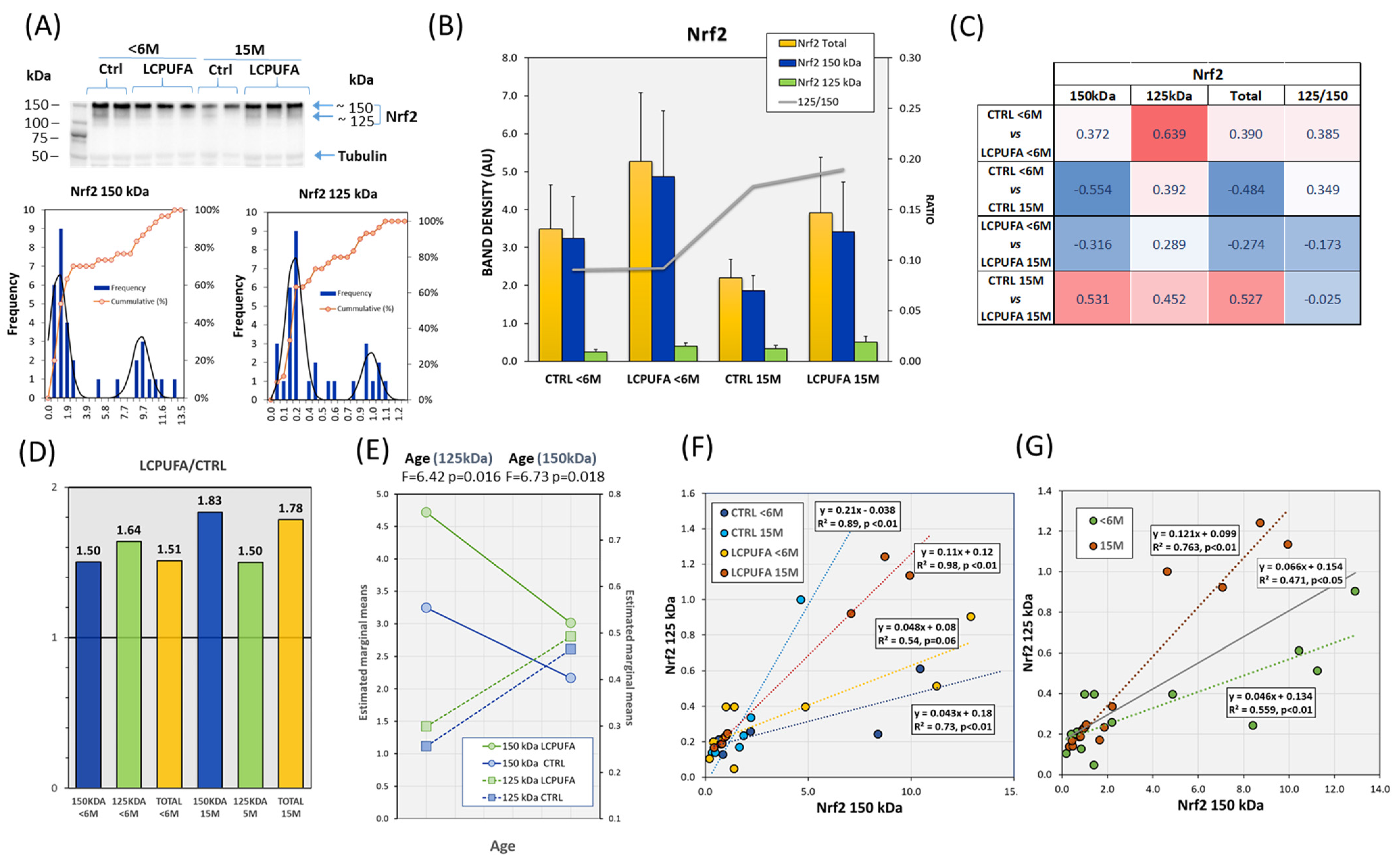
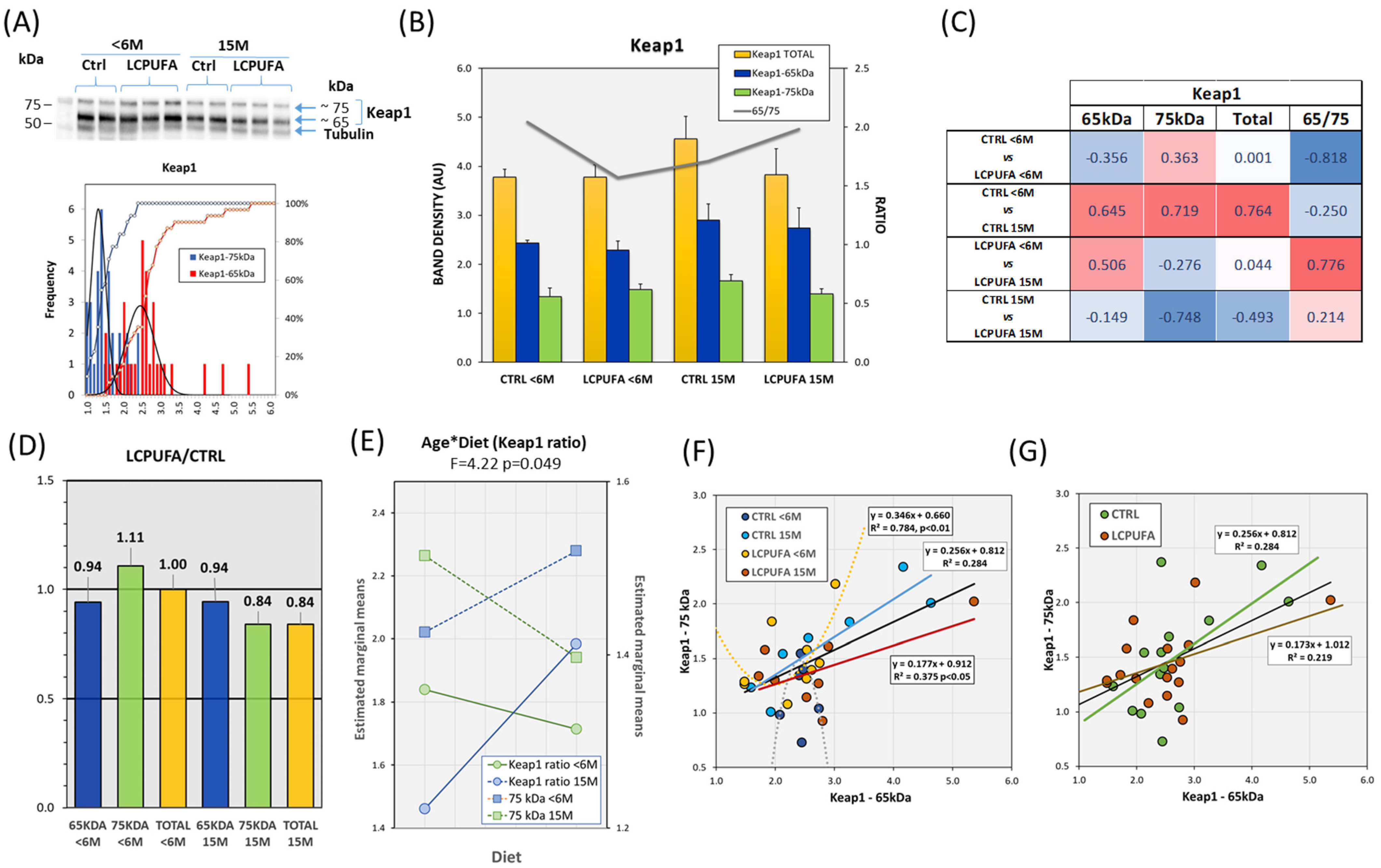
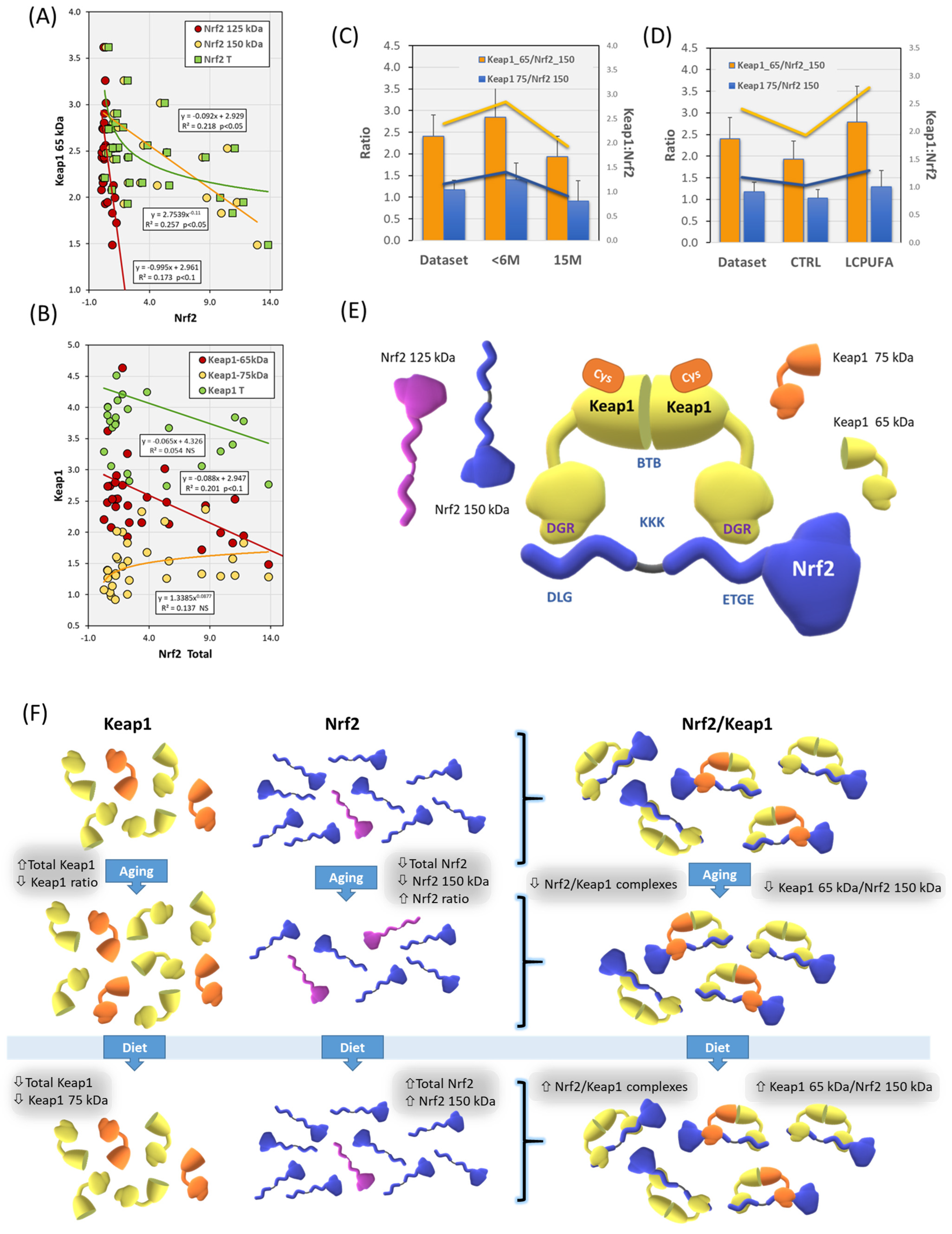

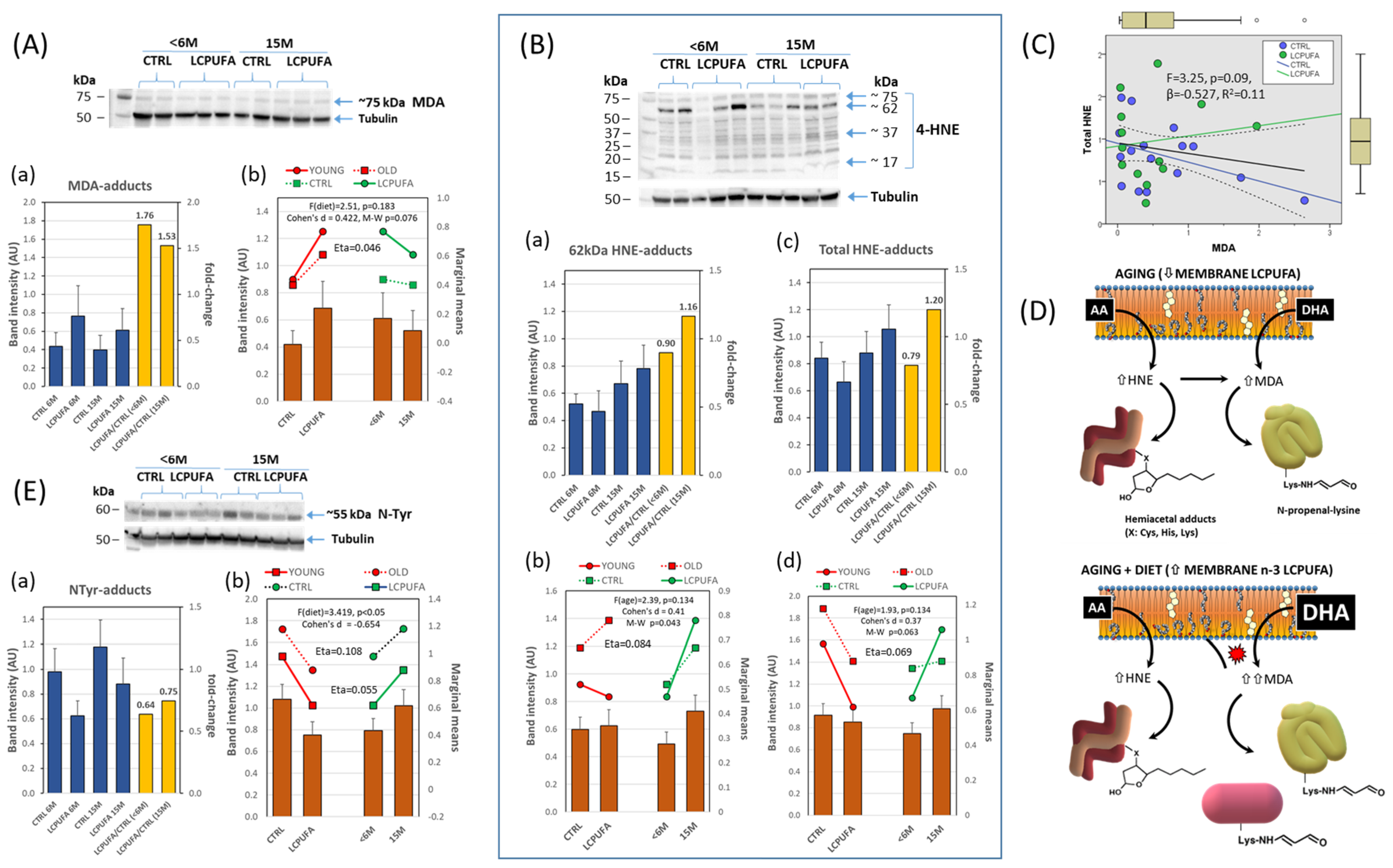
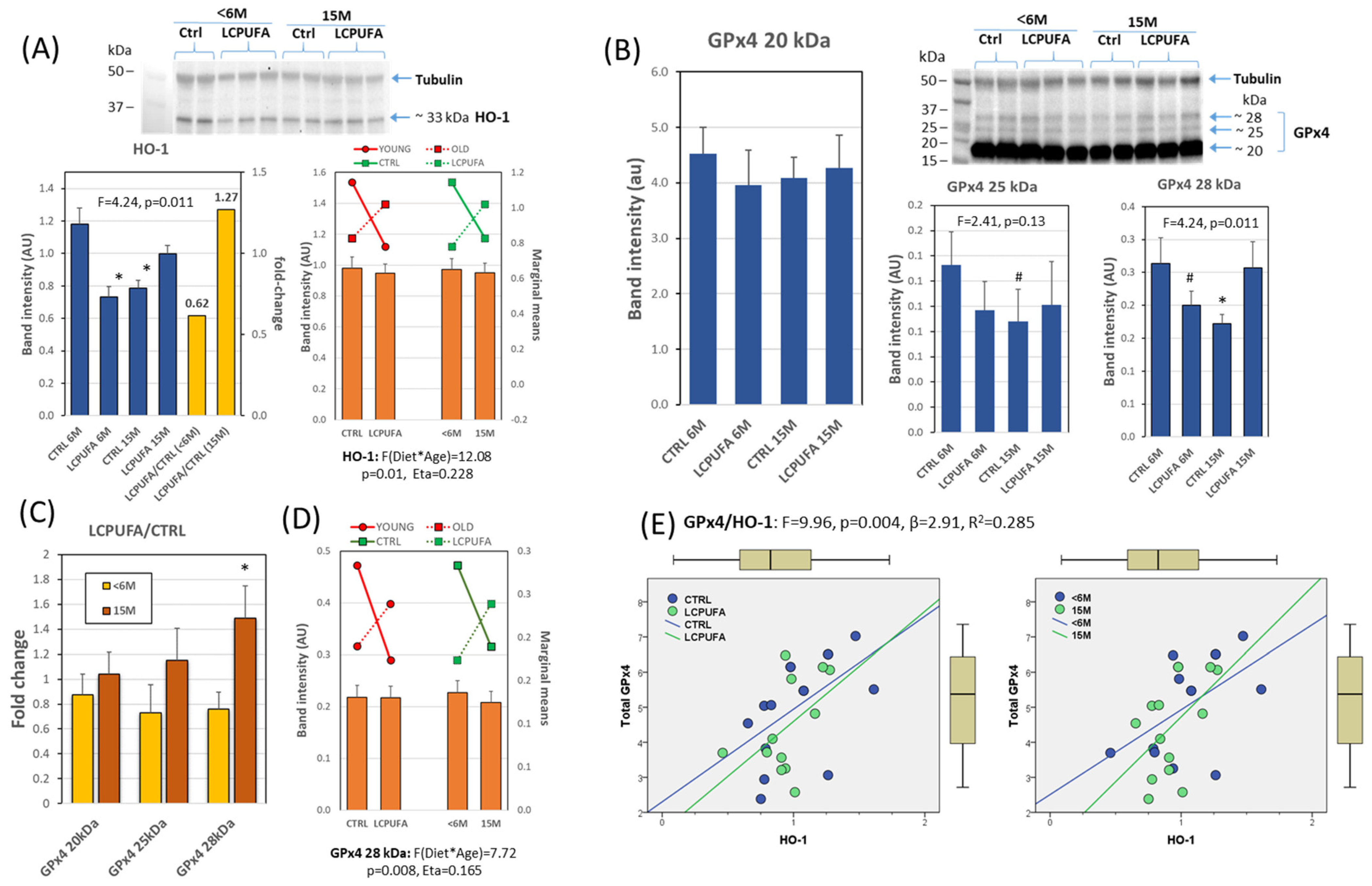
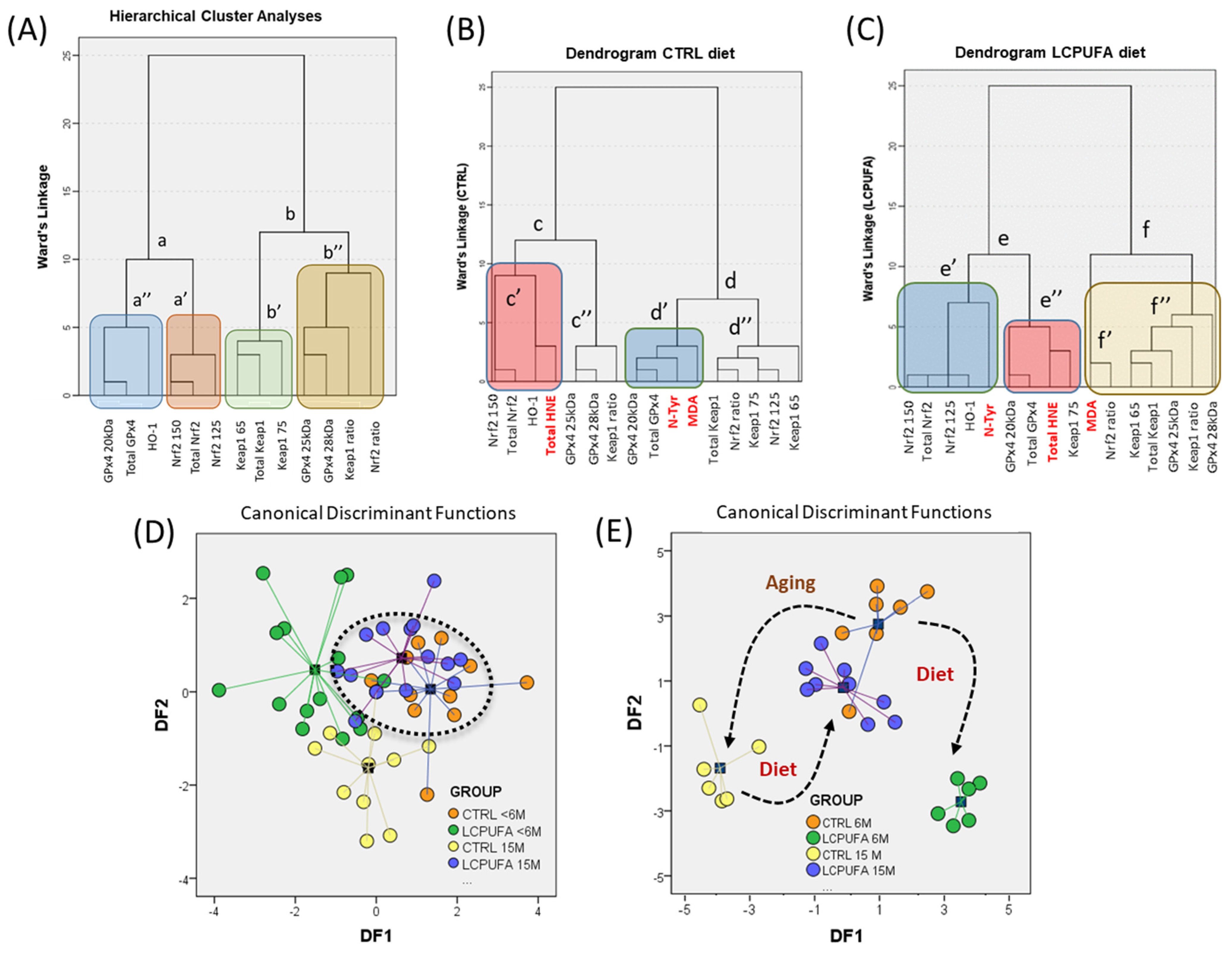
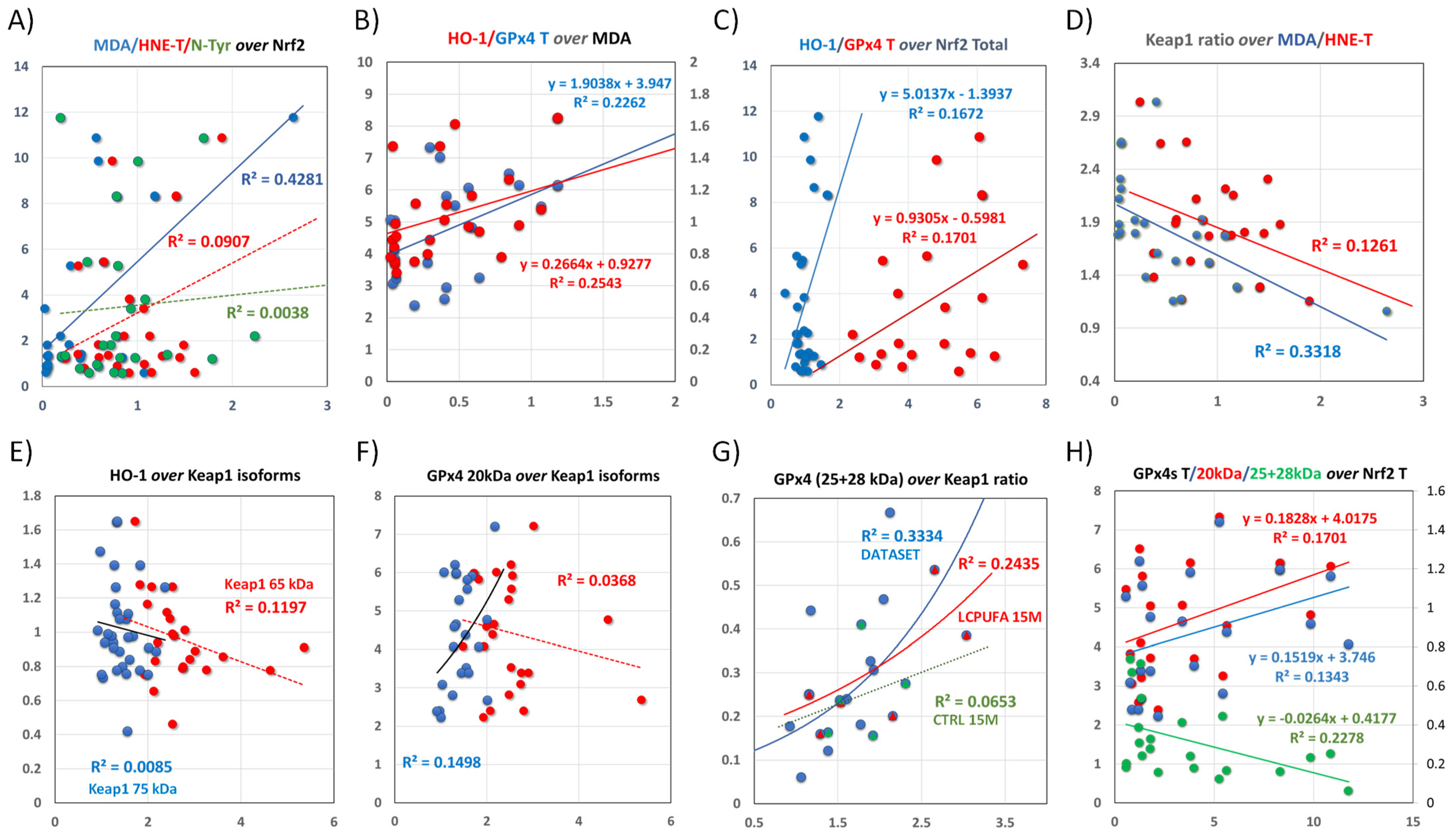
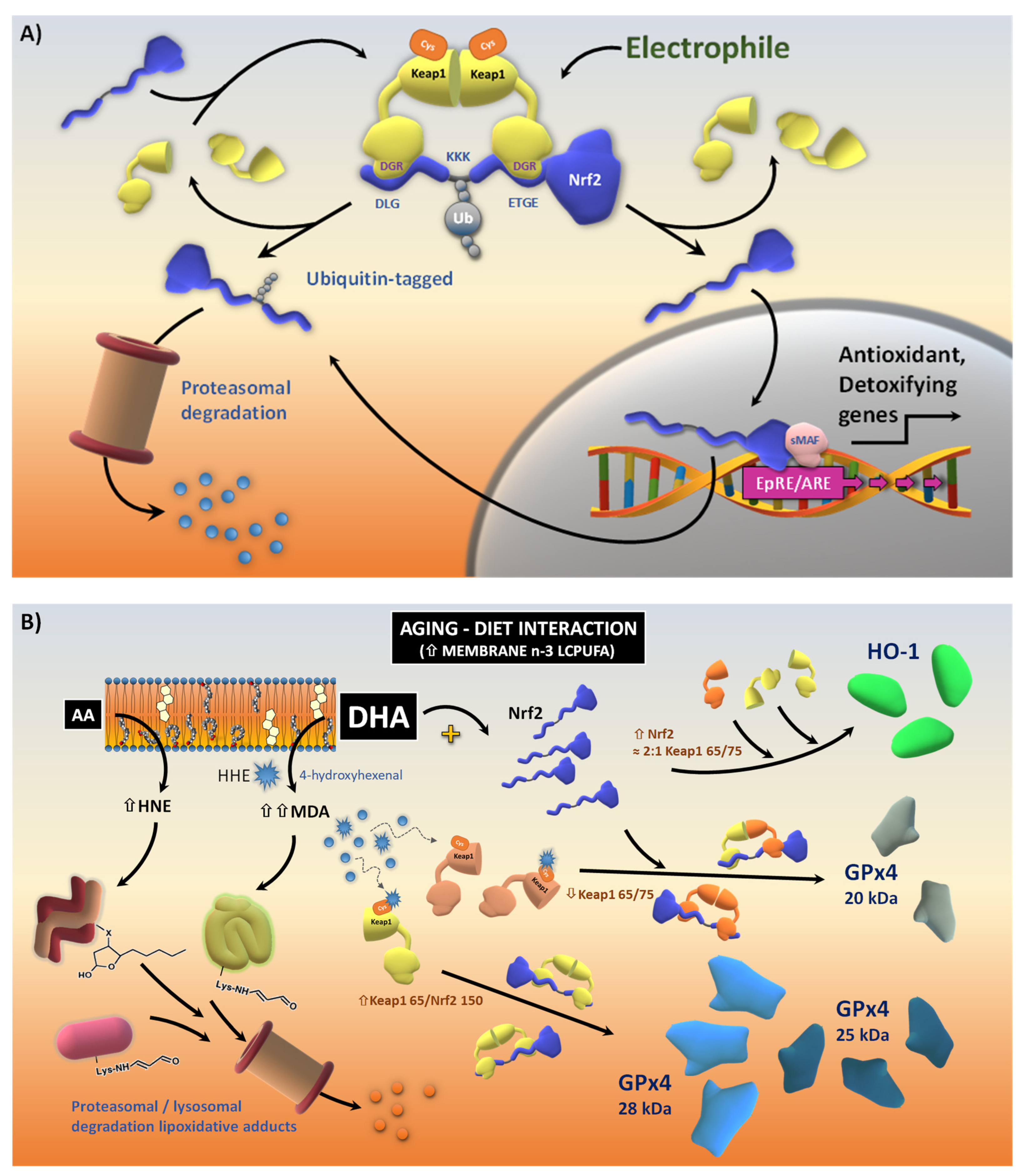
| (A) | Partial Correlations (Control Variables AGE&DIET) | ||||||||||
| Correlations DATASET | Keap1-65kDa | Keap1-75kDa | Keap1 65/75 | Keap1 Total | Nrf2 150 kDa | Nrf2 125 kDa | Nrf2 125/150 | Nrf2 Total | Keap1 65/ Nrf2 150 | Keap1 75/ Nrf2 150 | |
| Pearson’s correlation | Keap1-65kDa | 0.335 | 0.431 | 0.640 | −0.440 | −0.466 | 0.280 | −0.484 | 0.498 | 0.440 | |
| Keap1-75kDa | 0.450 | −0.512 | 0.615 | 0.443 | 0.193 | −0.267 | 0.454 | −0.309 | −0.261 | ||
| Keap1 65kDa/75kDa | 0.529 | −0.351 | 0.113 | −0.761 | −0.525 | 0.473 | −0.709 | 0.622 | 0.552 | ||
| Keap1 Total | 0.774 | 0.634 | 0.321 | −0.060 | −0.229 | −0.007 | −0.090 | 0.084 | 0.126 | ||
| Nrf2 150 kDa | −0.440 | 0.290 | −0.742 | −0.223 | 0.639 | −0.693 | 0.924 | −0.726 | −0.740 | ||
| Nrf2 125 kDa | −0.416 | 0.070 | −0.484 | −0.275 | 0.690 | −0.136 | 0.668 | −0.476 | −0.468 | ||
| Nrf2 125/150 | 0.294 | −0.237 | 0.426 | −0.024 | −0.552 | −0.074 | −0.616 | 0.809 | 0.839 | ||
| Nrf2 Total | −0.406 | 0.376 | −0.682 | −0.151 | 0.928 | 0.701 | −0.495 | −0.689 | −0.695 | ||
| Keap1 65/Nrf2 150 | 0.351 | −0.261 | 0.538 | 0.070 | −0.610 | −0.458 | 0.796 | −0.608 | 0.971 | ||
| Keap1 75/Nrf2 150 | 0.266 | −0.245 | 0.464 | 0.057 | −0.613 | −0.460 | 0.807 | −0.604 | 0.980 | ||
| (B) | Diet: LCPUFA | ||||||||||
| Correlations DIET | Keap1-65kDa | Keap1-75kDa | Keap1 65/75 | Keap1 Total | Nrf2 150 kDa | Nrf2 125 kDa | Nrf2 125/150 | Nrf2 Total | Keap1 65/ Nrf2 150 | Keap1 75/ Nrf2 150 | |
| Diet: CONTROL | Keap1-65kDa | 0.415 | 0.591 | 0.891 | −0.578 | −0.566 | 0.609 | −0.546 | 0.382 | 0.296 | |
| Keap1-75kDa | 0.524 | −0.294 | 0.685 | 0.185 | 0.037 | −0.253 | 0.268 | −0.288 | −0.280 | ||
| Keap1 65kDa/75kDa | 0.402 | −0.469 | 0.449 | −0.780 | −0.538 | 0.603 | −0.683 | 0.551 | 0.490 | ||
| Keap1 Total | 0.656 | 0.593 | 0.120 | −0.394 | −0.353 | 0.351 | −0.325 | 0.168 | 0.125 | ||
| Nrf2 150 kDa | −0.145 | 0.685 | −0.727 | 0.228 | 0.728 | −0.785 | 0.908 | −0.699 | −0.691 | ||
| Nrf2 125 kDa | −0.167 | 0.160 | −0.357 | −0.093 | 0.390 | −0.377 | 0.748 | −0.589 | −0.574 | ||
| Nrf2 125/150 | −0.030 | −0.244 | 0.216 | −0.245 | −0.429 | 0.331 | −0.703 | 0.882 | 0.914 | ||
| Nrf2 Total | −0.156 | 0.670 | −0.732 | 0.207 | 0.995 | 0.479 | −0.373 | −0.676 | −0.662 | ||
| Keap1 65/Nrf2 150 | 0.277 | −0.290 | 0.623 | −0.074 | −0.680 | −0.383 | 0.612 | −0.689 | 0.985 | ||
| Keap1 75/Nrf2 150 | 0.179 | −0.240 | 0.449 | −0.033 | −0.624 | −0.355 | 0.655 | −0.633 | 0.959 | ||
| (C) | Age: 15M | ||||||||||
| Correlations AGE | Keap1-65kDa | Keap1-75kDa | Keap1 65/75 | Keap1 Total | Nrf2 150 kDa | Nrf2 125 kDa | Nrf2 125/150 | Nrf2 Total | Keap1 65/ Nrf2 150 | Keap1 75/ Nrf2 150 | |
| Age: <6M | Keap1-65kDa | 0.693 | 0.646 | 0.814 | −0.513 | −0.510 | 0.044 | −0.520 | 0.613 | 0.527 | |
| Keap1-75kDa | 0.162 | −0.044 | 0.697 | 0.010 | −0.057 | −0.315 | 0.002 | 0.107 | 0.114 | ||
| Keap1 65/75 | 0.287 | −0.647 | 0.462 | −0.680 | −0.601 | 0.429 | −0.680 | 0.717 | 0.596 | ||
| Keap1 Total | 0.560 | 0.780 | −0.095 | −0.358 | −0.462 | −0.254 | −0.375 | 0.376 | 0.378 | ||
| Nrf2 150 kDa | −0.503 | 0.448 | −0.831 | −0.089 | 0.874 | −0.417 | 0.998 | −0.701 | −0.712 | ||
| Nrf2 125 kDa | −0.361 | 0.280 | −0.555 | 0.015 | 0.748 | −0.090 | 0.901 | −0.605 | −0.632 | ||
| Nrf2 125/150 | 0.580 | −0.210 | 0.467 | 0.198 | −0.607 | −0.088 | −0.384 | 0.754 | 0.720 | ||
| Nrf2 Total | −0.310 | 0.711 | −0.767 | 0.253 | 0.894 | 0.448 | −0.588 | −0.699 | −0.712 | ||
| Keap1 65/Nrf2 150 | 0.343 | −0.448 | 0.595 | −0.118 | −0.617 | −0.423 | 0.824 | −0.593 | 0.971 | ||
| Keap1 75/Nrf2 150 | 0.257 | −0.420 | 0.564 | −0.105 | −0.631 | −0.424 | 0.856 | −0.596 | 0.982 | ||
Disclaimer/Publisher’s Note: The statements, opinions and data contained in all publications are solely those of the individual author(s) and contributor(s) and not of MDPI and/or the editor(s). MDPI and/or the editor(s) disclaim responsibility for any injury to people or property resulting from any ideas, methods, instructions or products referred to in the content. |
© 2024 by the authors. Licensee MDPI, Basel, Switzerland. This article is an open access article distributed under the terms and conditions of the Creative Commons Attribution (CC BY) license (https://creativecommons.org/licenses/by/4.0/).
Share and Cite
Díaz, M.; Valdés-Baizabal, C.; de Pablo, D.P.; Marin, R. Age-Dependent Changes in Nrf2/Keap1 and Target Antioxidant Protein Expression Correlate to Lipoxidative Adducts, and Are Modulated by Dietary N-3 LCPUFA in the Hippocampus of Mice. Antioxidants 2024, 13, 206. https://doi.org/10.3390/antiox13020206
Díaz M, Valdés-Baizabal C, de Pablo DP, Marin R. Age-Dependent Changes in Nrf2/Keap1 and Target Antioxidant Protein Expression Correlate to Lipoxidative Adducts, and Are Modulated by Dietary N-3 LCPUFA in the Hippocampus of Mice. Antioxidants. 2024; 13(2):206. https://doi.org/10.3390/antiox13020206
Chicago/Turabian StyleDíaz, Mario, Catalina Valdés-Baizabal, Daniel Pereda de Pablo, and Raquel Marin. 2024. "Age-Dependent Changes in Nrf2/Keap1 and Target Antioxidant Protein Expression Correlate to Lipoxidative Adducts, and Are Modulated by Dietary N-3 LCPUFA in the Hippocampus of Mice" Antioxidants 13, no. 2: 206. https://doi.org/10.3390/antiox13020206
APA StyleDíaz, M., Valdés-Baizabal, C., de Pablo, D. P., & Marin, R. (2024). Age-Dependent Changes in Nrf2/Keap1 and Target Antioxidant Protein Expression Correlate to Lipoxidative Adducts, and Are Modulated by Dietary N-3 LCPUFA in the Hippocampus of Mice. Antioxidants, 13(2), 206. https://doi.org/10.3390/antiox13020206








